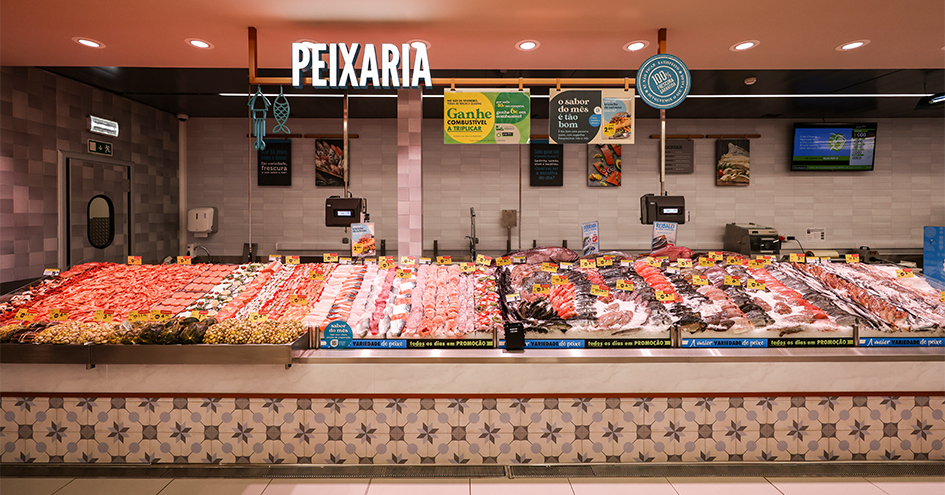Hand in hand with the fight against plastic pollution and the implementation of good production practices throughout the supply chain, our Sustainable Fishing Strategy also contributes to fighting pollution and the overexploitation of the aquatic environment. Our Companies’ commitment to following this strategy ensures that our Private Brand and perishable fish products do not contribute to the overexploitation, depletion or extinction of species1.

In 2023, we remained faithful to our commitment to annually assess the risk level of all species of fish species in the Group’s Private Brand and perishable assortments, in a clear reinforcement of self-requirement in relation to the every three year periodicity that was in force until 2021. We sold more than 210 species of fish, continuing to invest in diversifying our assortment as a way of reducing pressure on the most consumed fish species.
Origin of perishable and private brand fish
in kg (2023)
The share of wild-caught fish increased slightly compared to 2022 (3 p.p. more). More than 30% of the fish sold in our stores are sourced from aquaculture, a system that helps to reduce pressure on wild fish stocks, particularly on species most sought after by consumers, such as salmon, sea bream, shrimp, trout and sea bass.
As regards the level of conservation of each of these species, we use IUCN data for wild-caught fish2, updated in April 2023. The IUCN categorises the different levels of threat as follows: Vulnerable (low risk), Endangered (medium risk) and Critically Endangered (high risk)3. The Not Evaluated, Data Deficient, Least Concern or Near Threatened categories are not considered threatened categories.
Conservation status of wild fish species
in kg (2022-2023)
In 2023, 35% of wild-caught fish in our Private Brands and perishables were classified as ‘Vulnerable’ (representing the lowest level of risk) and more than 55% of our wild fish purchases do not present a conservation risk (‘Near Threatened’ and ‘Least Concern’ categories). One flounder species, Hippoglossoides platessoides, fell under the ‘Endangered’ category, representing less than 0.1% of total purchases (in kg). However, this species was purchased before the IUCN updated its conservation status, so it is deemed to be in full compliance with our Sustainable Fishing Strategy. No purchases of species considered to be ‘Critically Endangered’ were made.
The table below depicts the level of compliance with the commitments at each of the three levels of conservation risk4.
IUCN Red List category |
|
Commitment |
|
Compliance in 2023 |
||||||||
|---|---|---|---|---|---|---|---|---|---|---|---|---|
Critically Endangered |
|
Ban the purchase and sale of species classified at this level of risk and for which there are no specific extraordinary permits or whose aquaculture production is not ensured across all stages of its life cycle. Only the European eel (Anguilla anguilla)1 falls into this risk category. It has not been marketed in our stores since 2016. In the assessment carried out in 2022, two other commercial species were identified under this level of risk: the Siberian sturgeon (Acipenser baerii) and the school shark (Galeorhinus galeus). In 2023, only the species Acipenser baerii was marketed, and we ensured aquaculture production for its entire life cycle. |
|
100% |
||||||||
Endangered |
|
Ban the marketing of species classified at this level of risk whenever they are not 100% obtained from aquaculture and/or from sustainably managed stocks and/or that do not have a certificate of sustainability (e.g., MSC or ASC). In 2023, we identified seven species falling under this category, to which we applied the foregoing measure: shortgfin mako (Isurus oxyrinchus); striped catfish (Pangasianodon hypophthalmus)2; smooth-hound (Mustelus mustelus); black hake (Merluccius senegalensis); undulate ray (Raja undulata), sandy ray (Raja Circularis) and American plaice (Hippoglossoides platessoides)3. |
|
100% |
||||||||
Vulnerable |
|
Limit promotional activities with species that are classified as ‘Vulnerable’ whenever they are not obtained from aquaculture and/or from sustainably managed stocks and/or that do not have a certificate of sustainability (e.g., MSC or ASC). In the 2023 assessment, we identified 20 species in this risk category, for which we limited promotional activities. |
|
100% |
||||||||
|
||||||||||||
In 2023, the codfish stocks in the coastal area of the Norwegian Sea, Spitzberg and Bear Island (FAO 27.2) and Atlantic bigeye tuna stocks remained unchanged compared to 2022. Changes in these stocks must continue to be monitored and the stock management plan complied with in the coming years.
1 This commitment is also set out in the Jerónimo Martins Sustainable Sourcing Policy, available on our corporate website on the Sourcing Responsibly and Sustainable Fishing pages.
2 Assessment is carried out using 2023 data from the IUCN Red List of Threatened Species, accessed through the Integrated Biodiversity Assessment Tool (IBAT) (http://www.ibat-alliance.org). This data is provided by BirdLife International, Conservation International, IUCN and UNEP-WCMC.
3 For the purposes of this analysis, the ‘Extinct in the Wild’ category is not considered since the species analysed are caught in the wild.
4 More information at www.iucn.org.
